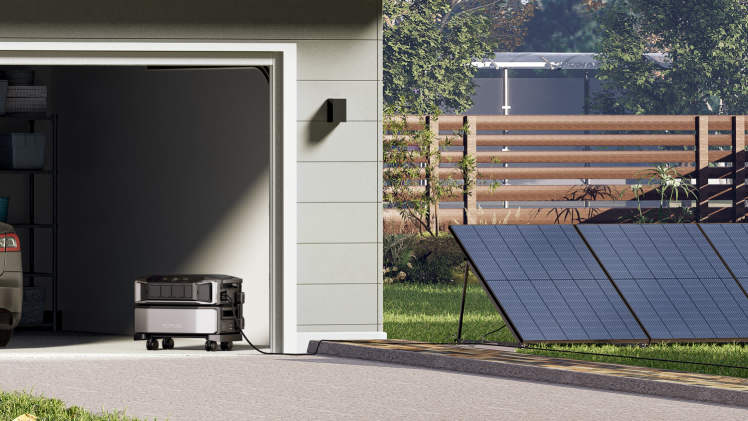What Is Needed to Run a House on Solar Power?
- Core Components of a Solar House Kit and Power System
- Inverters: Power Converters
- How to Design and Size Your Solar House Kit
- Confirm You Have Adequate Space
- How to Install Your Solar House Kit: Required Steps
- How to Connect Your Solar System to the Electrical Grid
- Battery Storage: When and Why You Might Need It for Your Home Solar System
- Build Your Solar-Powered Home!
Solar power allows you to convert sunlight into home-useable electricity. It's beneficial for the environment as well as helps you cut power bill expenses. To make it run, you will need some key components including storage systems and solar panels, which are sometimes available as complete solar house kits. Having solar panels makes smart financial sense as power gets more costly. Nowadays, many homes are adopting systems as they provide consistent, clean energy and they perform effectively.
Core Components of a Solar House Kit and Power System
A residential solar power system depends on a number of fundamental parts cooperating. Every component has a distinct function in converting sunlight into practical electricity.
Solar Panels: Energy Collectors
Sunlight is gathered by solar panels and turned into power. Usually mounted on rooftops or open ground with good sun exposure, they are composed of silicon cells set in rectangular frames. Your available area and energy consumption will determine how many panels you require. Most home systems run either polycrystalline panels (more reasonably priced, albeit less efficient) or monocrystalline panels (more efficiency, more expensive).
Inverters: Power Converters
Solar panels produce direct current (DC) electricity, but homes use alternating current (AC). Inverters handle this necessary conversion. Common options include:
String inverters: Connect multiple panels together, cost-effective for simple installations
Microinverters: Attach to individual panels, perform better when some panels are shaded
Power optimizers: Improve panel performance before sending electricity to a central inverter
Mounting Systems: Panel Supports
These systems fastly fix solar panels to your ground or roof. Mounting hardware of quality is crucial since it will shield your panels and property from years of weather exposure. Depending on your property and tastes, options consist in ground mounts, roof mounts, or pole mounts.
Wiring and Connectors: Electricity Pathways
The electrical components connecting your system should be made especially for solar use. Safely delivering power from panels to your home's electrical system, this sophisticated wiring manages external circumstances, temperature variations, and UV exposure.
Monitoring System: Performance Tracker
Tracking power output from your solar system is done via monitoring equipment. While more sophisticated options offer real-time performance statistics through smartphone apps or web portals, basic systems indicate daily generation. This visibility lets you check your system is running as it should and identify possible problems early on.
Any home solar power system is built upon these five parts. These components can be purchased individually or as an integrated solar house kit. When chosen and installed correctly, they cooperate to give your house consistent renewable energy.

How to Design and Size Your Solar House Kit
Knowing the elements you need will help you decide on the appropriate size and arrangement for your house.
Measure Your Home's Energy Consumption
Start by looking at utility statements for a whole year to capture seasonal variations as well as average usage. All later calculations start with your daily kilowatt-hour needs. Remember to plan for future needs, whether those include running new equipment or charging an electric car. Before moving further, think about making efficiency improvements all around your house; naturally, this lowers the system capacity needed and might help to save thousands of equipment costs.
Assess Your Available Sunlight
The solar potential of your land depends on various geographic considerations. First, using local weather records, find the average peak solar hours for your area. Roof orientation is quite important; surfaces facing south in the Northern Hemisphere get most solar exposure. Mature trees or nearby buildings can create shadows that greatly reduce output capacity by themselves. Your calculations also have to consider seasonal fluctuations in sun trajectory since winter usually results in less solar energy than summer.
Calculate the Right System Size
Determining ideal system size entails dividing your daily energy consumption by the peak solar hours of your area. When computing these figures, include inevitable efficiency losses—usually between 20 and 25 percent of potential output. Choose if your objective is total energy independence or only percentage-based utility cost reduction. While online calculators offer approximations, expert solar designers use advanced modeling tools including your particular structural and geographic elements for exact sizing.
Confirm You Have Adequate Space
Every residential installation requires physical space—about 15 to 20 square feet per conventional panel. Beyond surface area, make sure your roof construction can securely handle the extra weight load. Local construction codes and homeowner association rules can unintentionally restrict system location and appearance. Ground-mounted arrays may help properties with limited roof availability if enough unshaded ground exists.
How to Install Your Solar House Kit: Required Steps
With your system designed and components selected, here's exactly what happens during the installation phase.
Obtain Local Electrical Permits and Building Approvals
Before beginning work, you will require permits. Generally speaking, most places call for building permits, electrical permits, and occasionally zoning approvals. For particular regulations, find out via your local building department Faster "solar-ready" permits are being provided at several locations. You will have to turn in structural details and system drawings including electrical diagrams. Give this process adequate time; depending on where you reside, permits can take a few days to many weeks.
Decide: Professional Installers vs. DIY Installation
Though costlier upfront, professional installations clearly pay off. Licenced installers have the knowledge, tools, and safety gear needed to correctly set up your system. They overcome unanticipated problems, prevent roof damage, and handle difficult electrical work. For DIY enthusiasts, pre-configured solar house kits are available that simplify the installation process, though professional guidance is still recommended. Furthermore provided by good installers are workmanship warranties.
If you're considering do-it-yourself, know that rooftop labor and perhaps dangerous electrical work constitute part of solar installations. You will need strong understanding of safety practices, building techniques, and electrical systems. Do-it-yourself installation may nullify equipment warranties and exclude you from incentive programs. Errors can compromise system performance, harm your property, or pose safety risks.
Complete the Four Physical Installation Steps
Regardless of who performs the work, installation follows a structured sequence:
Mount the racking system - Secure mounting hardware to your roof's structural elements, creating a solid foundation for your solar array.
Install the solar panels - Attach panels to the mounting framework in your predetermined configuration, ensuring proper spacing and alignment.
Run electrical wiring - Establish conduit and wiring systems that create safe pathways from your array to your inverter location, properly grounded and weather-protected.
Connect the inverter - Mount your inverter in a suitable location (typically near your electrical panel) and integrate the system with your home's electrical infrastructure.
Throughout this process, installers must follow manufacturer specifications precisely to maintain warranty coverage and ensure optimal performance.
Pass Electrical and Building Code Inspections
Your system needs independent validation following installation. Local electrical inspectors will examine the wiring, grounding, and connections of your system. Before grid connection, several utility firms additionally carry out their own examinations. These tests guard against electrical risks for anyone. Approved will provide formal evidence proving your system's compliance, which is crucial for insurance and next property transactions.

How to Connect Your Solar System to the Electrical Grid
You must connect your system to the electricity grid after installation and inspection, unless you're going off-grid. This connection controls your utility company-system interaction.
Apply for a Utility Interconnection Agreement
You must have a utility company agreement before connecting to the grid. This document explains how your system will connect to their network and who is responsible. You'll describe your system's size, equipment, and safety. Processing can take days or months, depending on location, so prepare ahead. Connecting without permission may breach regulations and impact your insurance.
Enroll in Net Metering to Receive Credits for Excess Power
Your system generates more electricity than you need? Use net metering. Your utility credits your account for this power, which lowers your bill when you draw from the grid at night or on overcast days.
Some utilities give you full retail value for your excess power, while others provide reduced wholesale rates. No matter how much power you generate, many levy monthly connection costs. Local utility policies greatly affect your system's payback period.
Consider the Off-Grid Alternative
If you're in a remote area or want complete energy independence, going off-grid is an option. These systems operate without any utility connection and require:
Larger solar arrays to generate extra energy for storage
Substantial battery systems to power your home when the sun isn't shining
Backup generators for extended periods of low solar production
Energy management systems to balance your power production and use
While off-grid systems offer freedom from utility companies, they typically cost more and require more hands-on management than grid-tied systems. They make the most sense for remote locations where running utility lines would be extremely expensive.
Battery Storage: When and Why You Might Need It for Your Home Solar System
While we've touched on batteries for off-grid systems, there are several other scenarios where battery storage becomes valuable for solar-powered homes.
When Battery Storage Makes Sense
Partial net metering programs - In areas where utilities provide less than full credit for excess energy
Time-of-use rate structures - When electricity costs more during evening peak hours than during sunny daytime hours
Grid reliability concerns - In regions prone to weather-related outages or infrastructure problems
Energy security priorities - For homeowners who value backup power for essential systems
Electric vehicle ownership - When you want to charge EVs with solar power regardless of time of day
Why Battery Storage Adds Value
Energy optimization - Store power when it's abundant and use it when it's needed most
Protection for critical systems - Keep medical equipment, refrigeration, or security systems running during outages
Rate arbitrage - Buy grid power when cheap and use stored power when rates are high
Reduced demand charges - Lower utility bills by avoiding peak usage spikes
Future-proofing - Prepare for evolving utility policies and rate structures
Battery technology continues to improve while costs decrease, making storage an increasingly attractive option even for homes with good grid connections. For those worried about frequent outages, EcoFlow's Smart Control Kit can connect directly to your home's circuits without complex rewiring, providing up to a week of backup power for essentials while integrating seamlessly with existing solar panels.
Build Your Solar-Powered Home!
Five basic components—Solar panels, inverters, mounting systems, specialized wiring, and monitoring equipment—are needed running a house on solar power. Success depends on your ability to appropriately size your system, estimate solar availability, determine your energy demands, and get required permissions. Whether you decide on expert installation or do-it-yourself, your system needs to pass tests before running independently or connected to the grid. Battery storage becomes quite important for total energy independence. Although the initial process requires investment and planning, a well-designed solar system offers decades of major cost savings and clean, dependable power.